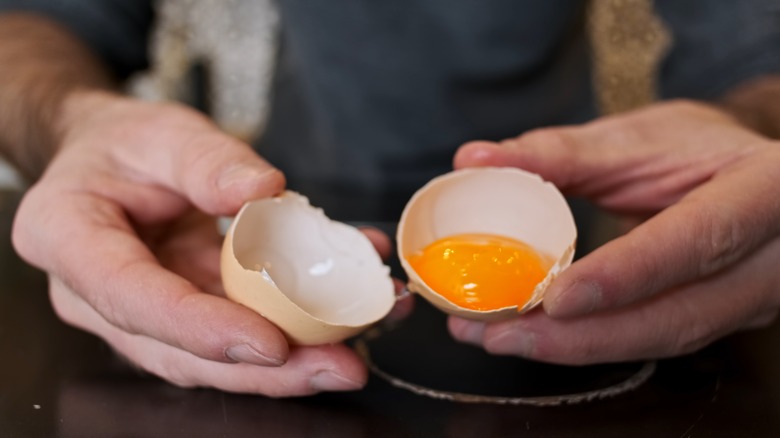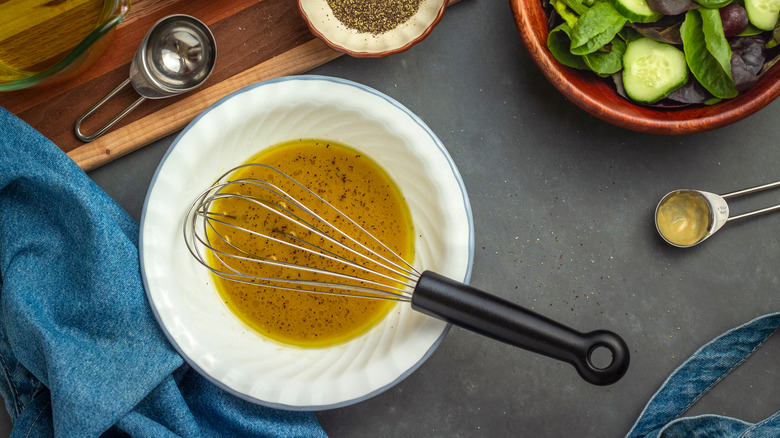The One Thing Ina Garten Always Makes Homemade
It's no secret that Ina Garten is a fan of store-bought substitutions when they taste as good as homemade ingredients. But there's one thing she always makes from scratch, and that's a vinaigrette salad dressing. "It's faster to make it than to go to the store and buy a bottle of dressing," Garten says, "And it's so much better" (via YouTube).
A classic vinaigrette consists of just a few ingredients — olive oil and an acid like vinegar or lemon juice, along with seasonings — but it transforms the simplest salad into something bright, fresh, and full of flavor. The Barefoot Contessa uses a measuring cup rather than a bowl to mix her dressing, which makes it even easier to measure the right quantity of each ingredient as you go.
The French golden ratio for vinaigrette is to use three parts oil to one part vinegar. Garten's go-to dressing is similar to this, but slightly heavier on the acid, as she uses half a cup (equivalent to eight tablespoons) of oil and three tablespoons of vinegar. She adds minced garlic, plenty of salt, and freshly-ground black pepper for an even fuller flavor. The pro chef also uses a slightly unconventional ingredient to make sure the dressing properly emulsifies, creating a cohesive, creamy texture.
Ina Garten adds egg yolk to emulsify vinaigrette
Making a vinaigrette is generally easy, but there's an unavoidable pitfall: Oil and vinegar don't want to mix. Vinegar is made up of polar molecules, whereas fats such as oil consist of non-polar molecules, and they're simply not attracted to one another. To get around this, Ina Garten adds the oil as the very last ingredient, and whisks it in slowly — a simple yet important step that she believes helps emulsification.
Garten further encourages the vinaigrette to hold together by adding a raw egg yolk. Just like when making your own mayonnaise, the egg acts as a binder, attracting both water and oil molecules so that they come together into a smooth mixture, rather than separating. Garten prefers to use organic eggs, and adds the yolk when it's at room temperature rather than fridge-cold.
If you don't want to consume raw eggs, you could add extra mustard, which acts as an emulsifying agent thanks to a compound known as mucilage. Garten uses Dijon, but you could use your favorite mustard instead. Just add around half a teaspoon for each tablespoon of vinegar, and as an added bonus, you'll get a deliciously tangy and sharp dressing.
More tips for mixing up the perfect vinaigrette
A basic vinaigrette is perfectly simple, but it can also be a blank canvas for different vinegars and oils. If you prefer a neutral taste, try grapeseed oil, or add a richer flavor with extra virgin olive oil. You could also incorporate walnut, sesame, or avocado oil to switch things up. Ina Garten likes to use Champagne vinegar, but apple cider vinegar also pairs great with mixed greens, or try red wine vinegar or balsamic for a richer color and complex flavor. Just avoid distilled white vinegar, as it's too harsh-tasting.
You could also switch out some of the vinegar for citrus such as lemon or lime juice for a bright burst of flavor. You could even try orange or grapefruit, if your salad has a fruity or summery vibe. Add a little sugar, honey, or syrup to the vinaigrette if you prefer a sweeter finish, or miso for an umami-rich result. Fresh herbs, garlic, or minced shallots all add more robust notes, too.
When it comes to combining the ingredients, Garten uses a whisk, but you could follow Bobby Flay's advice for better vinaigrette and use a blender to make it easier. Once you've made your vinaigrette, it will keep for around three days in the refrigerator, ready to elevate salads, sandwiches, and more.



